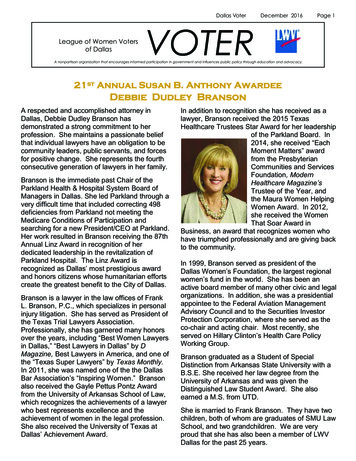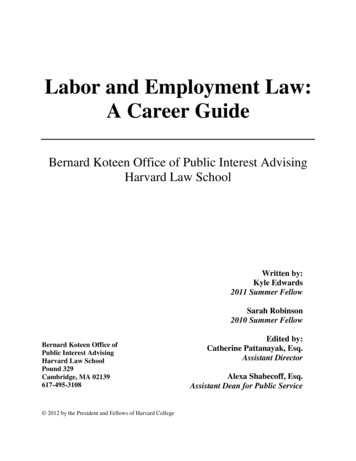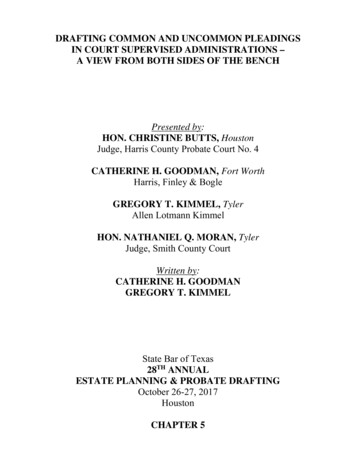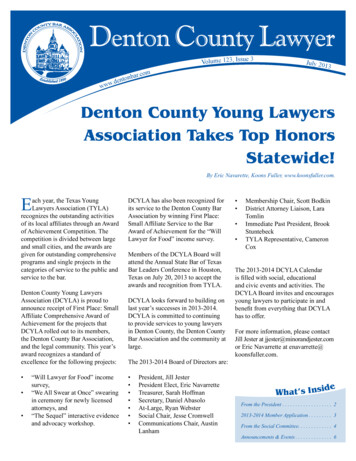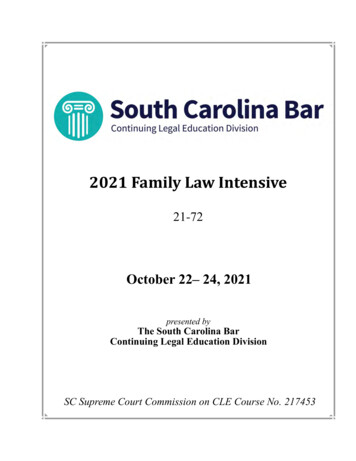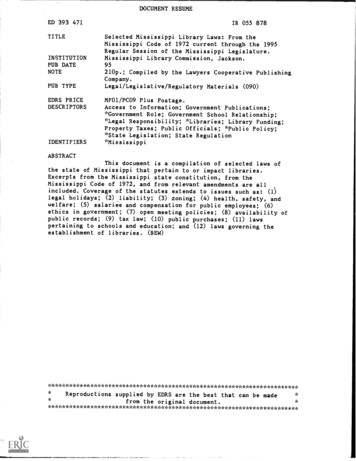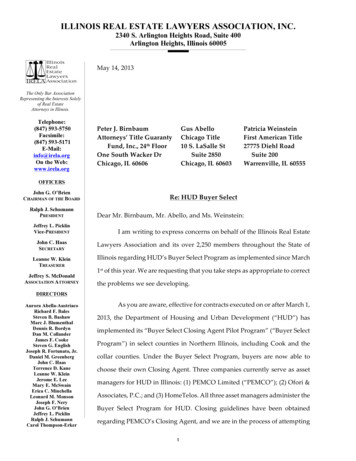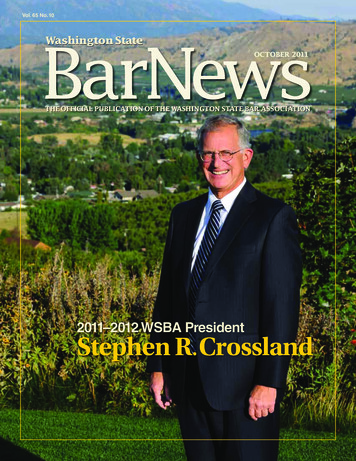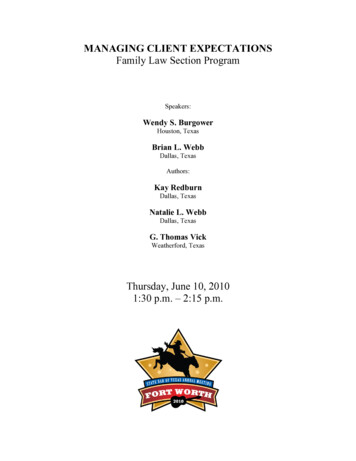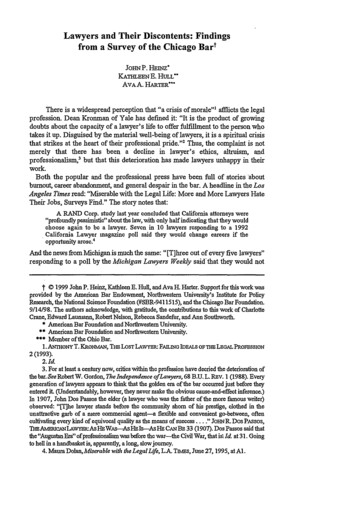
Transcription
Lawyers and Their Discontents: Findingsfrom a Survey of the Chicago BartJOHN P. HEINz*KATHLEEN E.HULLAvAA. -IARTER"There is a widespread perception that "a crisis of morale"' afflicts the legalprofession. Dean Kronman of Yale has defined it: "It is the product of growingdoubts about the capacity of a lawyer's life to offer fulfillment to the person whotakes it up. Disguised by the material well-being of lawyers, it is a spiritual crisisthat strikes at the heart of their professional pride."' Thus, the complaint is notmerely that there has been a decline in lawyer's ethics, altruism, andprofessionalism,3 but that this deterioration has made lawyers unhappy in theirwork.Both the popular and the professional press have been full of stories -aboutburnout, career abandonment, and general despair in the bar. A headline in the LosAngeles Times read: "Miserable with the Legal Life: More and More Lawyers HateTheir Jobs, Surveys Find." The story notes that:A RAND Corp. study last year concluded that California attorneys were"profoundly pessimistic" about the law, with only half indicating that they wouldchoose again to be a lawyer. Seven in 10 lawyers responding to a 1992California Lawyermagazine poll said they would change careers if the4opportunity arose.And the news from Michigan is much the same: "[T]hree out of every five lawyers"responding to a poll by the Michigan Lawyers Weekly said'that they would not0 1999 John P. Heinz, Kathleen E. Hull, and Ava H.Harter. Support for this work wasprovided by the American Bar Endowment, Northwestern University's Institute for PolicyResearch, the National Science Foundation (#SBR-9411515), and the Chicago Bar Foundation.9/14/98. The authors acknowledge, with gratitude, the contributions to this work of CharlotteCrane, Edward Laumann, Robert Nelson, Rebecca Sandefur, and Ann Southworth.* American Bar Foundation and Northwestern University.** American Bar Foundation and Northwestern University.*** Member of the Ohio Bar.1. ANTHONY T. KRoNMAN, TBm LoST LAwYmn FAIMNcG IDEALS OF T E LEGAL PROFESSION2(1993).2. Id.3. For at least a century now, critics within the profession have decried the deterioration ofthe bar. SeeRobertW. Gordon, The Independence ofLawyers, 68 B.U.L. REv. 1 (1988). Everygeneration of lawyers appears to think that the golden era of the bar occurred just before theyentered it (Understandably, however, they never make the obvious cause-and-effect inference.)In 1907, John Dos Passos the elder (a lawyer who was the father of the more famous writer)observed: "[T]he lawyer stands before the community shorn of his prestige, clothed in theunattractive garb of a mere commercial agent-a flexible and convenient go-between, oftencultivating every kind of equivocal quality as the means of success . JoHNR. Dos PAssos,TBAMmmCAN LAWYERAs I-IFWAs-As HEIS-As I-ICANBE 33 (1907). Dos Passos said thatthe "Augustan Era" ofprofessionalism was before the war-the Civil War, that is Id. at 31. Goingto hell in a handbasket is, apparently, a long, slow journey.4. Maura Dolan, Miserablewith the LegalLife,LA.TIMEs, June 27,1995, at Al.
INDIANA LAW JOURNAL[Vol. 74:735become lawyers if they had it all to do over again.5 From the Denver BusinessJournal,headline: "Running from the Law: Attorneys After Happiness Find It inOther Jobs."6 Another: "In a recent poll conducted by the CaliforniaBarJournal,only 52 percent of that state's attorneys said they would still choose to becomelawyers. Seventy-five percent did not want their children to become lawyers."7From the ClevelandPlainDealer."Runaway Lawyers: Case Closed: Attorneys Quitto Preach, Teacl Find Happiness."8 From the Arizona Republic: "Grim Reality HasLawyers Looking for New Career . One estimate puts the number at 30,000 ayear."9 Consider this: "Almost a third of lawyers in a Florida survey reportedfeeling depressed once a week, and a university study in North Carolina revealedthat 11% of attorneys in the state considered taking their own lives at least once amonth."" All of these reports, of course, are based upon research, most of itdreadful.Maybe Chicago lawyers are special. The research reported in this Article hasquite different findings. When we asked Chicago lawyers how satisfied they werewith their jobs, 84% reported that they were either satisfied or very satisfied-about10% were neutral, 5% were dissatisfied, and only 1.6%.were very dissatisfied. Weanalyze those findings in greater detail below, with particular attention todifferences among the lawyers by gender, race, and practice setting. But first weshould make note of some of the previous research that has been done on jobsatisfaction, both in the legal profession and in other occupations.RESEARCH ON JOB SATISFACTIONOur findings are generally consistent with the previous scholarly research onoccupational satisfaction. That research indicates that most employed persons, inall professions and in all types of positions, are satisfied with their careers.Firebaugh and Harley, using the General Social Survey data for 1972 through 1991,found that six out of seven American workers reported being "moderately" or"very" satisfied with their jobs, and that this remained steady over the twenty yearperiod." Women were similar to men in this regard. 2 Given the competing familyand career demands on women and their generally lower salaries and occupationalrank, one might expect more women to be dissatisfied with their jobs, but severalstudies have found that women's attitudes toward their jobs are at least as favorable5. MarciaM McBrien,FaxPoll: Unhappy Lawyers Cite Hard Work Few Rewards, MICH.LAw. WKLY., Dec. 26,1994, at 1.6. Tom Locke, Runningfrom the Law, DENY. Bus. J., Apr. 22, 1994, § 2, at 3.7. McBrien, supra note 5, at 1.8. Diane Solov, Runaway Lawyers: Case Closed: Attorneys Quit to Preach, Teach, FindHappiness, PLAIN DEALER (Cleveland), Mar. 26, 1995, at 1 (Business Section).9. Colb Covert, Grim Reality Has Lawyers Lookingfor New Career, ARIZ. REPUBLIC, July25, 1994, atEl.10. Kate Muir, Counselfor the Depressed and the Stressed, TIMEs (London), July 13, 1995,at 16.11. Glenn Firebaugh & Brian Harley, Trends in Job Satisfaction in the UnitedStates by Race,Gender, and Type of Occupation, 5 RES. Soc. WoRK 87, 87 (1995).12. See id.
1999]LAWYERSAND THEIR DISCONTENTSas, and in some cases more favorable than, those of men. 3 Racial differences in jobsatisfaction, however, have been found in several studies. Firebaugh and Harley'sfinding that blacks report lower job satisfaction than whites 4 is largely attributableto the lower satisfaction of black women, who show significantly higher discontentthan white women. Austin and Dodge, also using General Social Survey data, foundthat blacks' discontent was more likely to exceed that of whites among persons ofhigh socioeconomic status.' Tuch and Martin found that the lower job satisfactionof blacks was mostly the result of structural factors rather than of differences in thework values of black and white workers. 6Older workers consistently report greater job satisfaction than younger workers.This is the case for men, women, blacks, and whites. 7 Four possible reasons havebeen suggested for the positive association between age and job satisfaction." First,older workers actuallyhave better jobs than younger workers because they are moreadvanced in their careers. Second, self-selection may have occurred so that olderworkers have, over time, sorted themselves into job positions they like. Third,expectations may decline with age-this suggests that workers' expectations adjustto conform to theirexperience over time, so that older workers' expectations are"ground down." 9 Fourth, younger workers are born to different generations thanolder workers, and these cohort or history effects may influence expectations and13. See Randy Hodson, GenderDifferencesin Job Satisfaction: WhyAren 'tWomen MoreDissatisfied?,30 Soc. Q. 385,396 (1989) (finding that 1975 Wisconsin data revealed "slightlygreaterjob satisfaction" for women). For similar findings, see also Aarcus CAMPBELL ET AL., TBEQuALrrY oFAMEimcAN L 'E:PRcEP'rIoNs, EVALUATIONS, AND SAnsFAcrioNs 300-01 (1976);Roy L. Austin & Hiroko Hayama Dodge, Despair,DistrustandDissatisfactionAmong Blacksand Women, 1973-1987,33 Soc. Q. 579, 580 (1992); Janet L. Bokemeier & William B.Lacy,Job Values, Rewards, and Work Conditionsas Factors in Job SatisfactionAmong Men &Women, 28 Soc. Q. 189, 195 (1992); and Clifford Mottaz, Gender Differences in WorkSatisfaction, Work-RelatedRewards and Values, and the Determinantsof Work Satisfaction,39HuM. REL. 359,360 (1986).14. Frebaugh & Hadey,supra note 11, at 99. The difference between blacks and whites wasabout one-fourth of a standard deviation. See id.15. Austin & Dodge, supra note 13, at 579.16. See Steven A. Tuch & Jack K. Martin, Race in the Workplace:Black1White Differencesin the Sources ofJob Satisfaction,32 Soc. Q. 103 (1991), which used data from the 1985 and1987-1989 General Social Surveys. This study did find a few interesting differences in thedeterminants ofjob satisfaction by race. Intrinsicjob rewards (specifically, autonomy and authority)significantly increase whites' satisfaction but not blacks' satisfaction, while urban residence andblue collar employment significantly decrease the job satisfaction of blacks but not of whites. Seeid. at 111-13.17. See Firebaugh & Harley, supranote 11, at 95; see also RiCHAD F. HAMILTON & JAMESD. WRIG T, T1m SrATP OF TiE MASSES 209-10 (1986) (discussing the higher satisfaction level ofolder individuals in most of their relationships); Duane F. Alwin & Jon A. Krosnick, Aging,Cohorts,andthe Stability of SociopoliticalOrientationsover the Life Span, 97 AM. J. Soc. 169passim (1991) (examining the hypothesis that attitude stability increases with age); Barbara J.Felton, Cohort Variationin Happiness:Some Hypotheses andExploratoryAnalyses,25 INT'LJ. AoiNG &HUM. Dsv. 27, 34-36 (1987) (analyzing the correlation between happiness and thesources ofhappiness among adults of varying ages).18. See Firebaugh & Harley, supranote 11, at 89.19. HAMILTON & WRImHT, supra note 17, at 209-14.
INDIANA LAW JOURNAL[Vol. 74:735levels of satisfaction. The last of these propositions, however, is inconsistent withsome of the data. Lower satisfaction in the more recent cohorts would result in adecrease in average satisfaction over time. Firebaugh and Harley found, however,that average satisfaction remained steady from 1972 to 1991.2" Thus, the higher jobsatisfaction of older workers appeared to be an age effect and not a cohort effect.Although there are some differences between types of work settings, from bluecollar jobs to professional positions, previous research suggests that, to a largeextent, each occupation faces similar problems and derives similar satisfaction, andlawyers are no exception.22 A study of job satisfaction among lawyers, doctors,engineers, and teachers in Australia found that the four professions exhibitedsimilar satisfaction/dissatisfaction tendencies.23 The study also found that womenlawyers were not as much concerned with intrinsic rewards, career advancement,or the public image of the profession as were their male counterparts.24In sharp contrast to most of the occupational satisfaction literature, however,some studies of women lawyers argue that gender is a significant determinant ofdiscontent within the bar. A study of the 1983 graduates of twenty law schoolsfound that 26% of women, but only 15% of men, expressed general careerdissatisfaction.25 A survey of 892 Stanford Law School graduates found that bothfemale and male graduates were very satisfied with their jobs, but that females weremore likely to report symptoms such as overeating, nightmares, crying, loneliness,and depression.2 6 The authors interpreted these findings as signifying that femaleprofessionals experience more stress than male professionals----"[t]his finding isconsistent with the literature that reveals that the strain of balancing career andfamily roles causes women to experience substantial psychological distress, andperhaps even psychological disorder."2720. See STA.NEYARoNoWrrZFALsEPRoMIsEs: Tim SHAPNG OFAMBRICAN WORKING CLASsCoNsciousN-ss 406-07 (1973), which offers the interpretation that young workers are lesssatisfied because they subscribe to a diffierent, less materialistic philosophy of-work.21. Firebaugh & Harley, supranote 11, at 102.22. See Elzbieta Malinowska-Tabaka, Complex Measures ofJob Satisfaction/DissatisfactionAmong Professionals,19 Soc. INDICATORS RES. 451,451 (1987).23. See id The variables analyzed included income, intrinsic rewards, time measures, serviceto community, prestige, career, and public image of the profession.24. See id. at 464; see also Carrie Menkel-Meadow, Feminization ofthe Legal Profession:The Comparative Sociology of Women Lawyers, in 3 LAWYERs IN SocIMTY: COvPARATiVETHoRoips 225-31 (Richard L. Abel & S.C. Lewis eds., 1988).25. See Marilyn Tucker et al., Whatever Happenedto the Classof 1983?, 78 GEo. L.J. 153,164 (1990); see also JLABRAMSoN&BARBARA FANKLIN, WHm ARE TBRY Now: TmE STORYoF T-m WOMaN OFH .VARDLAw SCHooL 1974 (1986) (discussing the general level of satisfactionof the women in the Harvard Law School class of 1974).26. See Janet Taber et al., Project, Gender,Legal Education,and the Legal Profession:AnEmpiricalStudy ofStanfordLaw Students and Graduates,40 STAN. L. REv. 1209, 1251-52(1988). Even though females reported more symptoms of stress, an overall satisfaction measuredid not find a significant gender difference. Females scored 5.31 and males 5.12 on a seven-point(7.0) scale indicating increasing levels of satisfaction. See id.at 1245.27.Id at 1258. The literature cited suggests that-women, of all professions, tend to report morepsychological disorder symptoms than do men.
1999]LA WYERS AND THEIR DISCONTENTSSurveys sponsored by the Young Lawyers Division of the American BarAssociation ("ABA") also found lower job satisfaction among women lawyers.2" In1984, 29% of female lawyers in private practice reported dissatisfaction with theircurrent job, as compared to 14% of male lawyers.29 The 1984 data indicated that21% of women and 18% of men in solo practice reported dissatisfaction; 40% ofthe women and 19% of the men among junior associates were dissatisfied; 25% ofwomen and 13% of men among senior associates were dissatisfied; and, amongpartners, the figures were 15% and 9%.3o A 1990 study found that 41% of womenand 28% of men in private practice expressed dissatisfaction."A number of studies suggest that women lawyers experience greater conflictbetween their work and family roles than do their male counterparts, largelybecause the women assume a heavier burden of family responsibilities. 2 Becauseof actual and anticipated work-family conflicts, women lawyers are said to adoptvarious coping strategies only rarely employed by men, including delayed marriageand parenthood, lengthy leaves of absence from paid employment, and part-timework arrangements. Moreover, employers' assumptions about women workers'future behavior and work commitment may further exacerbate the situation.33 TheABA Commission on Women found that 70% of men, but only 25% of women, saidthat family obligations had no effect on their career choices.34Sex discrimination and sexual harassment within the legal profession might alsolead to greater dissatisfaction among women. Some commentators have argued thatwomen's increasing numerical representation within the profession has drivendiscrimination underground: While overt discrimination has become less common,women continue to experience adverse treatment in the form of structural barriersand covert expressions of hostility toward their presence in the law. Theprototypical legal career continues to be based on a male career model in whichtotal commitment to work life is both possible and desirable.3"A small survey of Arizona lawyers found that women reported experiences ofheightened visibility (in the form of compliments unrelated to achievement andlower credibility in professional settings), polarization (enforced through sexistjokes and remarks byjudges and male lawyers), and stereotyping (being patronized,28.ABA.YoNGLAwYERs DIvisioN, THE STATE OF THE LEGALPRoFESSiON 53-54 (1990).BERNARD F. LENTn & DAVID N. LABAND, SEx DISCRIMINATION IN THE LEGALPROFESSION (1995), for further analysis ofthe ABA Young Lawyers Division surveys.29. See A.BA. YOUNG LAWYERS DIvIsION, supra note 28, at 54 tbl.70.30. See id. at 54 tbl.71.31. See id. at 54 tbl.70.32. See CYNTIAFUCHS EPsTEIN, WOMEN NLAW 366-78 (1981); Linda Liefland, CareerPatternsofMaleandFemaleLawyers,35 BuFF.L. Rnv. 601,613-17 (1986); Taber etal., supranote 26, at 1228-31.See also33. See William T. Bielby & Denise D. Bielby, Family Ties: BalancingCommitment to WorkandFamily in DualEarnerHouseholds, 54 AM. Soc. REV. 776,778 (1989).34. See MARILYNTUCKER& GEORGIAA. NIEDZIELKO, OPTIONS AND OBSTACLES:A SURVEYOF THE STUDIES OF THE CAREERS OF WOMEN LAWYERS 32 (1994) (eiting COMMISSION ON THESTATUs OF WOMEN iN THE LEGAL PROFESSION, NORTH CAROLINABAR AsSOcrION 52 (1983)).35. See Martha W. Bamett, Women PracticingLaw: Changes in Attitudes, Changes inPlatitudes,42 FLA. L. REv. 209,212-16,218 (1990).
INDIANA LAW JO URNAL[Vol. 74:735referred to by their first name, and asked whether they are lawyers).36 The vastmajority of women surveyed perceived gender bias in the profession, but malerespondents were less likely to perceive bias. Another survey of 220 womenlawyers in a Midwestern state capital collected information on their experiences ofdiscrimination, gender disparagement, and sexual harassment in their work in theprofession. 3 7 These respondents reported less discrimination at the "front door" (inrecruitment and hiring) than on the job (in pay, promotions, and work assignments).Higher levels of discrimination were reported by women in the private sector andby women inworkplaces where less than 20% of the lawyer population wasfemale.3" Women with a careerist professional orientation were actually more likelyto report experiences of harassment than women with a feminist orientation,contradicting the common assumption that feminist lawyers are more likely toperceive and report sexist behaviors.39Research on women's status in the English legal profession was consistent withsome of these findings. Interviews with seventy-six women lawyers revealed thatfew women had experienced overt discrimination, but most felt that discriminationoperated in subtle yet pervasive ways to shape women's choices and opportunitiesin law." Interviews with thirty-two male English lawyers explored how women'smarginalization is accomplished.41 Specifically, these interviews examined maleasswmptions about the nature of the legal profession and women lawyers. Therespondents characterized the profession as aggressive, objective, logical, andpragmatic (in short, as male).42 The male lawyers felt that women should learn tocope or get out of the profession, and they expressed no awareness of the possibilitythat the profession might change to accommodate women's needs andperspectives.43 They attributed prejudice against women to clients, but not to malelawyers themselves.44 Respondents tended to view women lawyers as sexualobjects,4" as "different,"46 and as either too tough or not tough enough,4 7 echoing thefamiliar double bind faced by women in the profession.In a major study of Toronto lawyers, however, Hagan and Kay found nosignificant difference between male and female lawyers in their levels of overall job36. See Patricia MacCorquodale & Gary Jensen, Women in the Law: Partnersor Tokens?, 7GENDER& SOC'Y 582, 582 (1993).37. See Janet Rosenberg et al, Now That We Are Here: Discrimination,Disparagemeni andHarassmentat Work and the Experience of Women Lawyers, 7 GENDER & SOC'Y 415, 415(1993).38. See id.at 425-28.39. See id. at 423-25.40. See Anne Spencer & David Podmore, Women Lawyers in England: The Experience ofInequality, 9 WORK& OccUPATIONS 337,357 (1982).41. See Anne Spencer & David Podmore, Women Lawyers-MarginalMembers of aMaleDominated Profession, in IN A MAN'S WORLD: ESSAYS ON WOMEN IN MALE-DOMINATED113 (Anne Spencer & David Podmore eds., 1987).42. See id. at 114-16.43. See id. at 117-18.44. See id.at 118-19.45. See id.at 123-25.46. Id. at 125-26.47. See id.at 128-29.PROFESSIONS
1999]LAWYERS AND THEIR DISCONTENTSsatisfaction.4 Of the 692 lawyers in their 1991 sample, 78.3% of the women and79.4% of the menwere found to be satisfied with their jobs. 49 A 1987 study of 521graduates of Minnesota's three law schools, from the classes of 1975, 1978, 1982,and 1985, found that only 7% of the respondents reported being either "dissatisfied"or "very dissatisfied" with their current jobs, and there was no significant differencein this between men and women.5" A survey sponsored by the New York LawJournalproduced similar findings.5 The sample included 401 lawyers throughoutNew York State, and found no significant difference in the job satisfaction of menand women. Women reported working fewer hours than men, but were more likelyto feel that their jobs interfered with their private lives.52 Almost three-fourths offemale lawyers said that their families had to deal with work-related stress behaviorat home, while 55% of male attorney; said that was true for their families.53 Morethan 50% of the women reported that, despite the demands of their careers, theyspent more time with their children than did their spouses, while only 4% of maleattorneys made the same claim.5 Only 4% of the men in the sample, but 15% of thewomen, said that the demands of their careers made them decide not to havechildren.55A study of graduates of the University of Michigan Law School, by DavidChambers, found that women with children continued to bear the principalresponsibilities for child care, but also found that these women were more satisfiedwith their careers and with the balance of their family and professional lives thanwere other women or men. 6 Chambers speculates that "multiple roles. providesatisfaction by offering variety and relief, by permitting a sense of mastery, and byproviding some broader perspective on the problems in any one setting."" TheABA Commission on Women in the Profession also found that having childrenadded to the career satisfaction of women lawyers.58 Nevertheless, when Chambers48. JOHNHAGAN&FIONAKAY, GENDiERINPRAOncE:A STUDY OF LAWYERs' LrvEs 155-56(1995).49. See iaat 169. The very small difference between men and women is not large enough tobe statistically significant, but it was consistent across practice settings. In a 1985 sample, there wasno distinct pattern of difference by gender. The Toronto study also suggested, however, thatwomen tended to express more dissatisfaction than men in group, open-ended discussion settings.See id.at 161.50. See Paul W. Mattessich & Cheryl W. Heilman, The CareerPaths ofMinnesota LawSchool Graduates:Does GenderMake a Difference?, 9 LAW &INEQ. . 59, 95 (1990). Theresponse rate in this survey was 90%. See id. at 63.51. See Edward A. Adams, Legal CareerExacts Steep PersonalPrice,N.Y. L.J., Feb. 7,1994, at 1.52. See id.53. See id.54. See id.55. See id.56. David L. Chambers,AccommodationandSatisfaction: Women andMen Lawyers andtheBalance of Work andFamily, 14 L. &Soc.INQUIRY251 (1989). The Michigan study includedmore than 1000 graduates ofthe 1976-1979 law school classes. See id.at 260.57. Id.at 254.58. See TUCKER &NrEDZmLKo, supranote 34, at 30-36.
INDIANA LAWJOURNAL[Vol. 74:735asked an open-ended question about balancing work and family, women voicedmany complaints about the competing demands.59In sum, the literature on the relationship between gender and lawyer jobsatisfaction is inconclusive. Studies report contradictory findings-that gender isnot correlated with job satisfaction, and that gender is correlated with jobsatisfaction. Moreover, some studies find that the balancing of family and job'demands has a negative impact on women's career satisfaction, while other studiesproduce opposite results. In analyzing the new Chicago data, we will look not onlyat general correlations between gender and job satisfaction but at the factors thatcontribute to satisfaction and whether those factors differ by gender.SAMPLE CHARACTERISTICSIn 1994 and 1995, the American Bar Foundation mounted a survey of a randomsample of Chicago lawyers drawn from all types of practice and, indeed, from thenonpracticing bar." Face-to-face interviews, averaging more than an hour in length,were conducted with 788 respondents, 82% of the target sample.6' The populationwas defined as lawyers with offices in the City of Chicago-these lawyers could,of course, reside elsewhere or have an additional office elsewhere. The names of thelawyers were drawn from the state's official list of licensed attorneys.62 Therespondents include solo practitioners, lawyers in firms, corporate house counsel,government lawyers, public defenders, judges, and law professors, as well aspersons who were retired, unemployed, or engaged in businesses other than law.This Article focuses primarily on lawyers who were practicing at the time of thesurvey. The practicing lawyer category used here excludes judges, judicial clerks,professors, retired or unemployed lawyers, lawyers in nonlegal jobs, and anyrespondent who reported that he or she devoted no time to the practice of law. Thusdefined, the practicing lawyer subsample includes 675 respondents, 185 females(27%) and 490 males (73%). We limit the analysis to practicing lawyers becausewe take it that the question at issue is the degree of satisfaction among lawyers whoare working in law jobs. It may be of interest to note, however, that the satisfactionlevel of lawyers who have left the practice of law for other work is not significantly59. Chambers, supranote 56, at 265.60. This project was a partial replication of an earlier survey, conducted in 1975. See JOHN P.HEIn & EDWARD 0. LAUmANrN, CHICAGO LAWYERS (1982). Any reference in this Article to the"Chicago survey" is to the 1994-1995 survey.61. Ofthe original targets, 8% had died, were over age 80 (the eligibility limit), had moved outofthe Chicago area, or could not be located after an exhaustive search of directories (and were thusassumed to have moved to another region). These persons were therefore excluded from the targetsample.62. All lawyers admitted to practice in Illinois are required to be registered with and to pay anannual fee to the Attorney Registration and Disciplinary Commission ("ARDC"), an agency underthe supervision of the Illinois Supreme Court. A lawyer who is not registered with ARDC is notin good standing. Though the official list maintained by ARDC is not made public, even forresearch purposes, the agency agreed to draw a random sample of names and addresses from thelist, following our procedures and specifications. We are grateful to the Illinois ARDC and its stafffor their cooperation in this project.
1999]LA WYERS AND THEIR DISCONTENTSdifferent from that of the practicing lawyers, at least among respondents to theChicago survey.Of the practicing lawyers in the sample, 15% were in solo practice, 16% in firmswith two to nine lawyers, 11% in firms often to thirty lawyers, 34% in firms withmore than thirty lawyers, 9% in government law offices, 12% house counselpositions, and 2% in public defender or legal services jobs. Only 3% were over agesixty-five, 27% were ages forty-six to sixty-five, 38% were thirty-five to forty-five,and 32% were under age thirty-five. Eight percent of the practicing lawyers weremembers of minority groups-Asian, Latino, or African American. Nearly half(45%) of the lawyers in the sample had attended one of four local law schools inChicago-Chicago-Kent, De Paul, John Marshall, and Loyola. Those schools eachsupplied from 10% to 13% of the total. The University of Illinois College of Lawsupplied 6.5% of the practicing lawyers, the University of Chicago had graduated5.3%, and Northwestern produced 7.1%. Other law schools supplying substantialnumbers of graduates to this sample of the Chicago bar were the University ofMichigan with 3.6%, Georgetown, Harvard, and the University of Wisconsin with3% each, and Indiana University with 2%.FINDINGSAs we noted briefly above, most Chicago lawyers appear to be satisfied with theirjobs. Respondents were asked to'rate their overall job satisfaction on a five-pointscale, ranging from one for "very dissatisfied" to five for "very satisfied." Amongpracticing lawyers, the mean response was 4.21. Our finding with regard to genderwas like that in most ofthe previous scholarly research on occupational satisfaction,but unlike that in some of the prior studies of lawyers. In the Chicago data, there isnot a statistically significant gender difference in overall satisfaction. Womenscored an average of 4.13 on the five-point scale and men an average of 4.24.Forty-two percent of the women and 46% of the men reported that they were verysatisfied with their jobs, and only 2% ofthe women and 1%of the men reported thatthey were very dissatisfied. But there are some large differences among othercategories of lawyers. Not surprisingly, for example, of the 178 lawyers in thesample who were earning 125,000 or more, only two individuals were eitherdissatisfied or very dissatisfied, but of those earning less than 60,000 per year,about 13% were dissatisfied or very dissatisfied.63 Age, of course, tends to berelated to income, and we see a similar pattern when we look at the correspondencebetween age and job satisfaction, but the pattern is even more pronounced. None ofthe respondents older than fifty-five reported being dissatisfied. No doubt this is,at least in part, a self-selection effect. Lawyers who continue to practice to the ageof fifty-six or beyond are likely to have been reasonably happy with their lot.Among the youn
choose again to be a lawyer. Seven in 10 lawyers responding to a 1992 California Lawyer magazine poll said they would change careers if the opportunity arose. 4 And the news from Michigan is much the same: "[T]hree out of every five lawyers" responding to a pol
